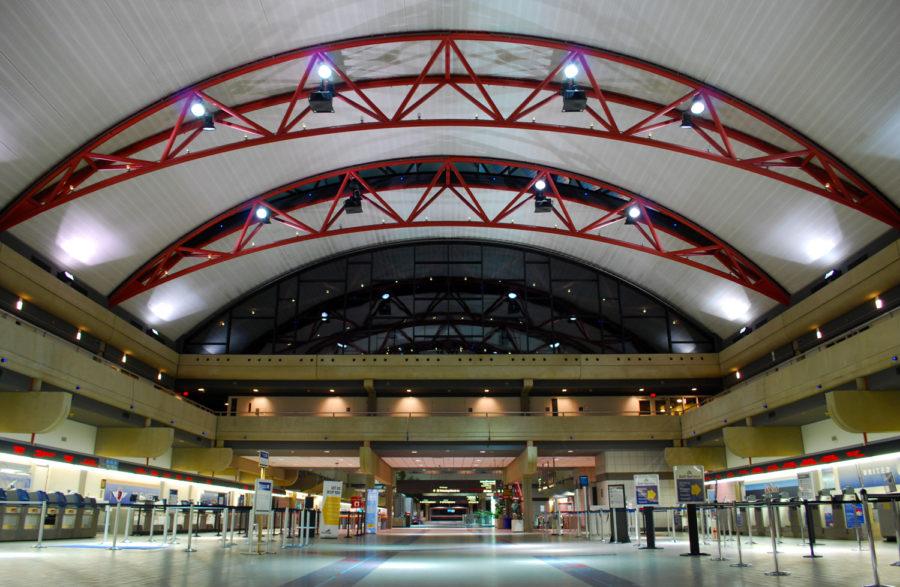Pittsburgh International Airport approves new budget for changes
Photo by John Marino via Wikimedia Commons
The 2019 operating budget for Pittsburgh International Airport is expected to increase by 3 percent, hitting an estimated $112.27 million.
November 2, 2018
Changes at Pittsburgh International Airport are getting ready for takeoff.
The Allegheny County Airport Authority, which operates Pittsburgh International and Allegheny County airports, convened for its monthly board meeting Oct. 19 and approved the airports’ budgets for next year with provisions for major renovations and significantly reducing passenger processing costs.
Pittsburgh International Airport’s 2019 operating budget is estimated to be $112.27 million, a 3 percent increase from this year’s budget of $108.97 million. The airport is also expected to incur less expense per passenger next year, following the trend of the past several years.
Pittsburgh’s cost per enplaned passenger, an industry benchmark that measures total airline operating expenses divided by the number of passengers, is forecasted to fall again this year. Since peaking in 2011 at $14.97 per passenger, the airport now projects it will only cost $10.35 in expenses to seat each passenger — a reduction of nearly 31 percent.
“We are lowering our costs because we’re paying off old debt and we’re growing,” Christina Cassotis, Allegheny County Airport Authority CEO, said in a press release announcing the budgets.
The reduction, in part, is due to an increase in revenue in recent years from nontraditional sources. As part of a 2013 agreement, the airport receives 18 percent in royalties on all natural gas produced on the 9,200 acres of land leased to gas company Consol Energy. Additionally, the airport has received $12.4 million annually since 2004 from a state economic development fund, paid for through gambling taxes.
The board also approved the capital budget for 2019, which dedicated $75 million to design work for the Authority’s $1.1 billion project to shrink and reconstruct the airport.
The project, known as the Terminal Modernization Program, aims to bring the airport into the 21st century by building a new central passenger terminal building with upgraded security and baggage processing areas, as well as a new 3,000-space parking garage.
“With this modernization of the terminal, our airport will be more efficient, there will be an enhanced customer experience, and it will be even more cost-competitive to airlines,” Rich Fitzgerald, County Executive for Allegheny County, said at an event announcing the project in fall of 2017. “This is a win-win for our region.”
The project is expected to create more than 6,000 direct temporary design and construction jobs, and more than 4,000 indirect temporary regional jobs, according to an Authority press release.
No increases in local taxes, landing fees or other levies that impact consumers will be imposed to pay for the project, according to the Robert Kerlik, an Authority spokesperson.
“The project is funded by the airlines through rates and charges, as well as through revenue such as parking, concessions, natural gas drilling, etc,” Kerlik said.
The current separate terminal building and tram that connects it to the gate concourses, would become obsolete with the project’s new central terminal building, which would be directly attached to the X-shaped gate concourses. By including new security screening areas, it’s estimated that the amount of time it takes to get from the airport’s curb to gates will be halved, according to the Authority.
The project is currently in the design phase, with initial designs to be made public early next year. Construction is expected to begin in fall of 2019, with the new terminal open in 2023, according to Kerlik.
Kerlik also said the project will also shrink the number of gates at the airport from 75 to 51 — a decrease of 32 percent — and a reflection of decreased passenger demand at the airport.
The current concourse building opened in 1992, and was largely financed by US Airways — now known as American Airlines — which operated a major hub in Pittsburgh at the time. As the number of flights in and out of Pittsburgh declined in the early 2000s, airlines merged together and the traditional hub-and-spoke network with connecting flights was replaced with more direct flights.
The facility, which was built to handle 35 million passengers a year with 100 gates, only serviced 8.9 million domestic and international passengers in 2017, according to Kerlik. As the terminal aged, many of the building’s systems escalators, walkways, pump systems and a large number of underutilized gates began to reach the end of their useful life, leaving the Authority with almost $200 million in deferred maintenance costs.
“We’re paying for a facility that is too expensive to maintain with technology and space configurations that were designed for a different time in aviation,” Cassotis said to the Pittsburgh Post-Gazette in September 2017.
Once airport operations move to the new terminal, it is unclear what the fate will be for the old building, Kerlik said. Possible options include demolition or sale to redevelop the property.
“We’re not that far along yet,” Kerlik said. “We’re at least five years away from moving out.”








